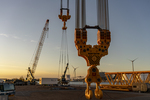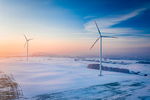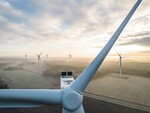12/17/2005
UK - Industry welcomes report on microgeneration potential
BWEA today welcomed a report from the Energy Saving Trust on the potential of microgeneration technologies such as small wind turbines, to contribute to the UK’s energy mix. The main findings of the Potential for Microgeneration - Study and Analysis report include:
- That by 2050 microgeneration could potentially provide 30-40% of the UK's total electricity needs.
- That by 2050 microgeneration could help to reduce CO2 emissions by 15% per year
According to the EST, small scale wind generation could reduce UK's CO2 emissions by 4% and provide 6% of UK's electricity demand by 2050, given appropriate support. Small scale wind could potentially total 15 GWe (gigawatt electricity) by 2050, assuming implementation of mechanisms such as streamlined planning process and adequate payment for exported electricity.
Mari Martiskainen, BWEA Communications and Small Wind Officer said:
"This report shows that microgeneration technologies such as small wind turbines can have an important role in our energy mix and gives a clear signal to Government on the support mechanisms required to make this market work. There is an increasing amount of interest and support for these technologies from politicians, industry and the public alike. It is vital that the Government’s Microgeneration Strategy, due in April 2006, takes bold action to make this potential into a reality."
The report was undertaken by the Energy Saving Trust on behalf of the DTI in conjunction with Element Energy Limited, E-Connect and Cambridge University Faculty of Economics. Executive summary is available at http://www.dti.gov.uk/energy/consultations/pdfs/microgeneration-est-summary.pdf.
The Chief Executive Philip Sellwood of the Energy Saving Trust, said:
"Our findings paint a promising picture for the future energy needs of the UK. Over the next 10 to 40 years a large proportion of homes in the UK could be generating their own energy, saving tonnes of carbon dioxide emissions and helping to prevent climate change."
- That by 2050 microgeneration could potentially provide 30-40% of the UK's total electricity needs.
- That by 2050 microgeneration could help to reduce CO2 emissions by 15% per year
According to the EST, small scale wind generation could reduce UK's CO2 emissions by 4% and provide 6% of UK's electricity demand by 2050, given appropriate support. Small scale wind could potentially total 15 GWe (gigawatt electricity) by 2050, assuming implementation of mechanisms such as streamlined planning process and adequate payment for exported electricity.
Mari Martiskainen, BWEA Communications and Small Wind Officer said:
"This report shows that microgeneration technologies such as small wind turbines can have an important role in our energy mix and gives a clear signal to Government on the support mechanisms required to make this market work. There is an increasing amount of interest and support for these technologies from politicians, industry and the public alike. It is vital that the Government’s Microgeneration Strategy, due in April 2006, takes bold action to make this potential into a reality."
The report was undertaken by the Energy Saving Trust on behalf of the DTI in conjunction with Element Energy Limited, E-Connect and Cambridge University Faculty of Economics. Executive summary is available at http://www.dti.gov.uk/energy/consultations/pdfs/microgeneration-est-summary.pdf.
The Chief Executive Philip Sellwood of the Energy Saving Trust, said:
"Our findings paint a promising picture for the future energy needs of the UK. Over the next 10 to 40 years a large proportion of homes in the UK could be generating their own energy, saving tonnes of carbon dioxide emissions and helping to prevent climate change."
- Source:
- BWEA
- Author:
- Edited by Trevor Sievert, Online Editorial Journalist
- Email:
- press@windfair.net
- Keywords:
- wind energy, wind farm, wind turbine, wind power, renewable energy, rotorblade, onshore, offshore


























